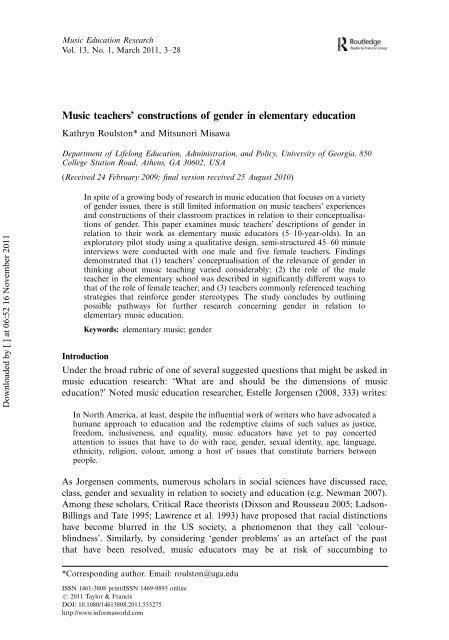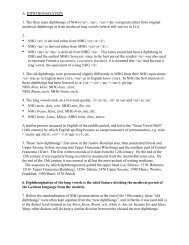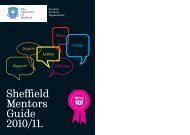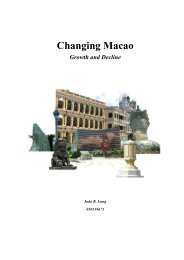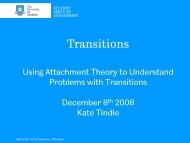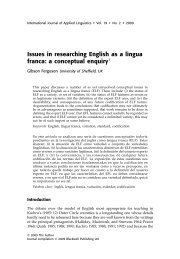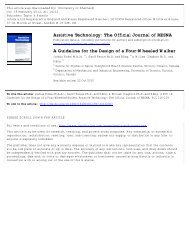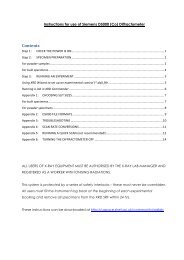Music teachers' constructions of gender in elementary education
Music teachers' constructions of gender in elementary education
Music teachers' constructions of gender in elementary education
You also want an ePaper? Increase the reach of your titles
YUMPU automatically turns print PDFs into web optimized ePapers that Google loves.
Downloaded by [ ] at 06:52 16 November 2011<br />
<strong>Music</strong> Education Research<br />
Vol. 13, No. 1, March 2011, 3 28<br />
<strong>Music</strong> teachers’ <strong>constructions</strong> <strong>of</strong> <strong>gender</strong> <strong>in</strong> <strong>elementary</strong> <strong>education</strong><br />
Kathryn Roulston* and Mitsunori Misawa<br />
Department <strong>of</strong> Lifelong Education, Adm<strong>in</strong>istration, and Policy, University <strong>of</strong> Georgia, 850<br />
College Station Road, Athens, GA 30602, USA<br />
(Received 24 February 2009; f<strong>in</strong>al version received 25 August 2010)<br />
In spite <strong>of</strong> a grow<strong>in</strong>g body <strong>of</strong> research <strong>in</strong> music <strong>education</strong> that focuses on a variety<br />
<strong>of</strong> <strong>gender</strong> issues, there is still limited <strong>in</strong>formation on music teachers’ experiences<br />
and <strong>constructions</strong> <strong>of</strong> their classroom practices <strong>in</strong> relation to their conceptualisations<br />
<strong>of</strong> <strong>gender</strong>. This paper exam<strong>in</strong>es music teachers’ descriptions <strong>of</strong> <strong>gender</strong> <strong>in</strong><br />
relation to their work as <strong>elementary</strong> music educators (5 10-year-olds). In an<br />
exploratory pilot study us<strong>in</strong>g a qualitative design, semi-structured 45 60 m<strong>in</strong>ute<br />
<strong>in</strong>terviews were conducted with one male and five female teachers. F<strong>in</strong>d<strong>in</strong>gs<br />
demonstrated that (1) teachers’ conceptualisation <strong>of</strong> the relevance <strong>of</strong> <strong>gender</strong> <strong>in</strong><br />
th<strong>in</strong>k<strong>in</strong>g about music teach<strong>in</strong>g varied considerably; (2) the role <strong>of</strong> the male<br />
teacher <strong>in</strong> the <strong>elementary</strong> school was described <strong>in</strong> significantly different ways to<br />
that <strong>of</strong> the role <strong>of</strong> female teacher; and (3) teachers commonly referenced teach<strong>in</strong>g<br />
strategies that re<strong>in</strong>force <strong>gender</strong> stereotypes. The study concludes by outl<strong>in</strong><strong>in</strong>g<br />
possible pathways for further research concern<strong>in</strong>g <strong>gender</strong> <strong>in</strong> relation to<br />
<strong>elementary</strong> music <strong>education</strong>.<br />
Keywords: <strong>elementary</strong> music; <strong>gender</strong><br />
Introduction<br />
Under the broad rubric <strong>of</strong> one <strong>of</strong> several suggested questions that might be asked <strong>in</strong><br />
music <strong>education</strong> research: ‘What are and should be the dimensions <strong>of</strong> music<br />
<strong>education</strong>?’ Noted music <strong>education</strong> researcher, Estelle Jorgensen (2008, 333) writes:<br />
In North America, at least, despite the <strong>in</strong>fluential work <strong>of</strong> writers who have advocated a<br />
humane approach to <strong>education</strong> and the redemptive claims <strong>of</strong> such values as justice,<br />
freedom, <strong>in</strong>clusiveness, and equality, music educators have yet to pay concerted<br />
attention to issues that have to do with race, <strong>gender</strong>, sexual identity, age, language,<br />
ethnicity, religion, colour, among a host <strong>of</strong> issues that constitute barriers between<br />
people.<br />
As Jorgensen comments, numerous scholars <strong>in</strong> social sciences have discussed race,<br />
class, <strong>gender</strong> and sexuality <strong>in</strong> relation to society and <strong>education</strong> (e.g. Newman 2007).<br />
Among these scholars, Critical Race theorists (Dixson and Rousseau 2005; Ladson-<br />
Bill<strong>in</strong>gs and Tate 1995; Lawrence et al. 1993) have proposed that racial dist<strong>in</strong>ctions<br />
have become blurred <strong>in</strong> the US society, a phenomenon that they call ‘colourbl<strong>in</strong>dness’.<br />
Similarly, by consider<strong>in</strong>g ‘<strong>gender</strong> problems’ as an artefact <strong>of</strong> the past<br />
that have been resolved, music educators may be at risk <strong>of</strong> succumb<strong>in</strong>g to<br />
*Correspond<strong>in</strong>g author. Email: roulston@uga.edu<br />
ISSN 1461-3808 pr<strong>in</strong>t/ISSN 1469-9893 onl<strong>in</strong>e<br />
# 2011 Taylor & Francis<br />
DOI: 10.1080/14613808.2011.553275<br />
http://www.<strong>in</strong>formaworld.com


